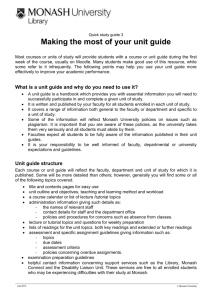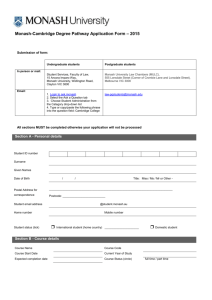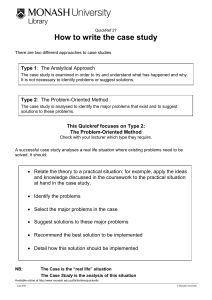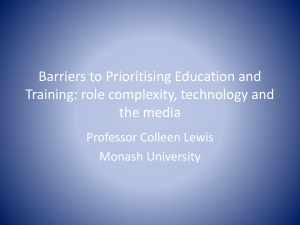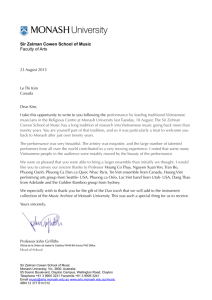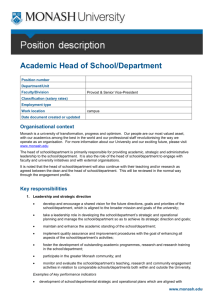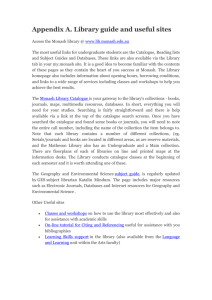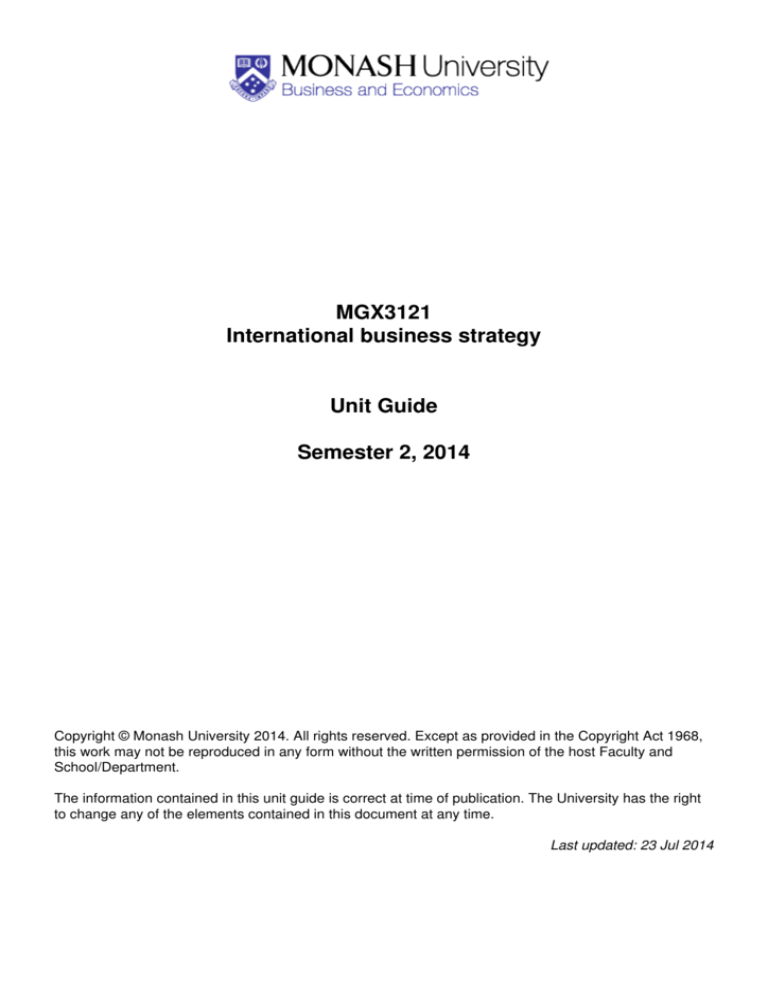
MGX3121
International business strategy
Unit Guide
Semester 2, 2014
Copyright © Monash University 2014. All rights reserved. Except as provided in the Copyright Act 1968,
this work may not be reproduced in any form without the written permission of the host Faculty and
School/Department.
The information contained in this unit guide is correct at time of publication. The University has the right
to change any of the elements contained in this document at any time.
Last updated: 23 Jul 2014
Table of Contents
MGX3121 International business strategy - Semester 2, 2014..............................................................1
Mode of Delivery..............................................................................................................................1
Workload requirements....................................................................................................................1
Additional workload requirements........................................................................................1
Unit Relationships........................................................................................................................................2
Prohibitions......................................................................................................................................2
Chief Examiner(s)........................................................................................................................................2
Campus Lecturer(s).....................................................................................................................................2
Berwick............................................................................................................................................2
Malaysia...........................................................................................................................................2
Tutor(s)........................................................................................................................................................2
Berwick............................................................................................................................................2
Malaysia...........................................................................................................................................2
Your feedback to Us....................................................................................................................................3
Previous Student Evaluations of this Unit....................................................................................................3
Academic Overview...................................................................................................................................4
Learning Outcomes.........................................................................................................................4
Unit Schedule.............................................................................................................................................5
Teaching Approach..........................................................................................................................5
Assessment Summary.....................................................................................................................6
Hurdle Requirements...........................................................................................................6
Second marking...................................................................................................................6
Return of final marks............................................................................................................7
Assessment criteria..............................................................................................................7
Assessment Requirements......................................................................................................................8
Assessment Tasks...........................................................................................................................8
Assessment task 1...............................................................................................................8
Assessment task 2...............................................................................................................9
Assessment task 3...............................................................................................................9
Examination(s)...........................................................................................................................................10
Examination 1................................................................................................................................10
Learning resources....................................................................................................................................10
Feedback to you........................................................................................................................................10
Extensions and penalties...........................................................................................................................10
Returning assignments..............................................................................................................................11
Referencing requirements.........................................................................................................................11
Assignment submission.............................................................................................................................11
Hard copy submission...................................................................................................................11
Online submission.........................................................................................................................11
Prescribed text(s) and readings.....................................................................................................11
Recommended text(s) and readings..............................................................................................11
Other Information....................................................................................................................................19
Policies..........................................................................................................................................19
Graduate Attributes Policy.................................................................................................19
Student Charter.........................................................................................................................................19
Student services........................................................................................................................................19
Monash University Library.........................................................................................................................19
Moodle 2....................................................................................................................................................19
Disability Liaison Unit................................................................................................................................20
MGX3121 International business strategy - Semester 2, 2014
This unit will concentrate on the nature and need for international strategy; the internationalisation
process; the context of international strategy; regional strategy; the dynamics of international
competition; role of culture in international strategy; corporate control of global corporations and strategic
forms of multinational corporations (MNCs); international strategy in services; modes and patterns of
international expansion and the management of international strategic cooperation; international strategy
and learning; MNCs political strategies; international strategy process and success of international
strategies; managing supply chain in the international arena.
Mode of Delivery
• Berwick (Day)
• Malaysia (Day)
Workload requirements
Minimum total expected workload equals 144 hours per semester
Additional workload requirements
This is a six credit point unit with three hours class contact per week over 12 teaching weeks. Students
enrolled in Coursework programs in the Faculty of Business and Economics are required to attend a
minimum of 80% of the scheduled class sessions for each unit. If you do not attend the required number
of classes, your performance could be compromised, and you may not be eligible to join a group for the
group assessment requirements if you are not present at class when the groups are assigned.
To be successful, it is expected you will need to invest 12 hours per week in this unit. To meet this
university expectation, you will need to invest nine (9) hours in self-directed study, in addition to the three
(3) hours of class contact, each week. Importantly, invest the 12 hours per week evenly over the
semester, starting in Week 1. As such, a fulltime student load is 48 hours per week, for 32 weeks of the
year, leaving 20 weeks without this investment. The time invested in study consequently means that,
during semester, other commitments may have a lower priority, which is then regained once semester is
finished.
A generally suggested time allocation each week is:
• 3 hours preparation for class (taking notes whilst completing readings, exercises, previewing
lecture notes and the like)
• 3 hours class time (in class taking notes, discussion, asking and answering questions, exercises
and the like)
• 3 hours completing assessment tasks (translating the preparation and class time activities into
assessment items, as well as undertaking further research as required)
• 1 hour self-reflection (reviewing notes and assessment as to the achievement of the topic’s
learning objectives – identify successes and continuing gaps)
• 1 hour study group (in a group of 4-5 students, reviewing the achievement of the topic’s learning
objectives and filling the learning gaps, and preparing for the next topic)
• 1 hour exam preparation, if applicable (reviewing the learning objectives to design probable exam
questions, and answering other students’ or provided practice exam questions). If your unit
doesn’t have an exam, this hour should be allocated to one or more of the above activities, as
appropriate.
1
MGX3121 International business strategy - Semester 2, 2014
It is recommended that these above tasks are distributed across the week (do not have one day on just
this unit), and that you also allocate a day or two each week without study (for any unit).
If you have not previously invested this amount of time in study, or feel you may need assistance
developing an appropriate time plan for yourself, please register for a time-management workshop with
Health and Wellbeing or the Library: https://my.monash.edu.au/news-and-events/bookings/
Unit Relationships
Prohibitions
MGG3121, MGW3121
Chief Examiner(s)
Mr Max Coulthard
Campus Lecturer(s)
Berwick
Mr Max Coulthard
Campus: Peninsula
Phone: +61 3 990 44261
Email: Max.Coulthard@monash.edu
Malaysia
Ms Adlina Ahmad
Campus: Malaysia
Email: Adlina.Ahmad@monash.edu
Tutor(s)
Berwick
Mr Max Coulthard
Campus: Peninsula
Phone: +61 3 990 44261
Email: Max.Coulthard@monash.edu
Malaysia
Ms Adlina Ahmad
Campus: Malaysia
Email: Adlina.Ahmad@monash.edu
2
MGX3121 International business strategy - Semester 2, 2014
Your feedback to Us
Monash is committed to excellence in education and regularly seeks feedback from students, employers
and staff. One of the key formal ways students have to provide feedback is through the Student
Evaluation of Teaching and Units (SETU) survey. The University’s student evaluation policy requires that
every unit is evaluated each year. Students are strongly encouraged to complete the surveys. The
feedback is anonymous and provides the Faculty with evidence of aspects that students are satisfied
and areas for improvement.
For more information on Monash’s educational strategy, see:
www.monash.edu.au/about/monash-directions/ and on student evaluations, see:
www.policy.monash.edu/policy-bank/academic/education/quality/student-evaluation-policy.html
Previous Student Evaluations of this Unit
If you wish to view how previous students rated this unit, please go to
https://emuapps.monash.edu.au/unitevaluations/index.jsp
3
Academic Overview
Learning Outcomes
The learning goals associated with this unit are to:
1. describe the concepts and use basic tools for competitive analysis and strategic planning in the
international environment
2. identify strategies for SMEs and multinational organisations to operate in a global setting
3. analyse the opportunities and risks involved in international strategic management and evaluate
the impact different modes of foreign operations have on the internationalising organisation
4. describe the influence of various stakeholders on the internationalising firm
5. identify how internal operations impact on the internationalisation process.
4
Unit Schedule
Week
Activities
Assessment
0
Please see the end of this unit guide for a detailed unit No formal assessment or activities are
schedule.
undertaken in week 0
1
Globalisation of Markets and Competition
2
Context of international strategy and the dynamics of
international competition
3
Context of international strategy and the dynamics of
international competition
4
Assessing Country Attractiveness
5
Political Issues facing internationalising organisations
6
Designing the international organisation
7
Entry Strategies
8
Strategic Alliances
9
Mergers and Acquisitions
10
International corporate governance; Corporate
Innovation and Entrepreneurship
11
International strategy in services
12
International strategies of small and medium
enterprises (SMEs)
Individual/Team presentations start
Individual essay due in class/tutorial
Major assignment due in class/tutorial
Individual/Team presentations finish
SWOT VAC
No formal assessment is undertaken
SWOT VAC
Examination period
LINK to Assessment Policy:
http://policy.monash.edu.au/policy-bank/
academic/education/assessment/
assessment-in-coursework-policy.html
Teaching Approach
• Lecture and tutorials or problem classes
This teaching and learning approach provides facilitated learning, practical exploration and peer
learning.
• Additionally, in the Department of Management, and in this unit, we adopt a pastoral care
approach to your academic progress and overall wellbeing as a student. University is a time of
change, which induces many responses including anxiety, stress and negative thoughts. This
time is more stressful with other changes within our lives outside of university. If you do need
assistance to manage these changes, or even just talk to someone, there is a lot of support
available, and support that will help. If your first contact cannot assist directly, they will know who
can, so please take the first step and ask.
♦ Please contact your lecturer: http://search.monash.edu/email/
♦ Online resources: http://www.monash.edu.au/counselling/self-help/
♦ Please contact counselling: http://www.monash.edu.au/counselling/
♦ Please contact medical services: http://www.monash.edu.au/health-medical/
♦ Please contact Faculty Student Services: http://www.buseco.monash.edu.au/contact.html
5
Unit Schedule
♦ Please contact Library and Learning Skills:
http://monash.edu/library/skills/resources/index.html
There are also other resources freely available, including:
♦ English as a Second Language (ESL) Growth: www.elg.edu.au
◊ If English is not your first language, check out these great exercises and tips to
maintain and enhance your English capacity
♦ Language and Learning Online: www.monash.edu.au/lls/llonline/
◊ Check out these great online learning workshops and tips for academic reading,
writing, listening, speaking, study skills and grammar.
If you are presenting academic at-risk triggers, including missing classes, late submissions, failing
assignments and the like, you may be contacted by your tutor or lecturer enquiring if further
support is needed. Please take advantage of these opportunities. If you are not contacted, though
feel you are at risk, please ask for support.
Again, it is an unfortunate though normal part of university life to be faced with some difficult
situations – there is help to deal with these so please ask for it.
Assessment Summary
Within semester assessment: 50%
Examination: 50%
Assessment Task Value
Due Date
Major Assignment
30%
Week 9 in class/tutorial
Presentation
10%
Between weeks 2-11
Essay
10%
Week 5 in class/tutorial
Examination 1
50%
To be advised
Hurdle Requirements
There is a hurdle requirement in this unit.
The learning outcomes in this unit require students to demonstrate in the individual summative
assessment task a comprehensive understanding of the topics covered in the unit. This is demonstrated
by the requirement that the student must attain a mark of at least 40% in the final summative task.
A student's final mark is normally the sum of the marks obtained in all of the individual assessment items
in the unit. Where a student fails the unit soley because of failure to satisfy the hurdle requirement a
mark of 48 will be returned for the unit.
Second marking
Where an assessment task is given a fail grade by an examiner, that piece of work will be marked again
by a second examiner who will independently evaluate the work, and consult with the first marker. No
student will be awarded a fail grade for an assessment task or unit without a second examiner confirming
6
Unit Schedule
the result.
Note: Exceptions to this are individual pieces of assessment contributing 10% or less of the final mark,
unless the total of such pieces exceeds 30% of the final mark.
Return of final marks
Faculty policy states that 'the final mark that a student receives for a unit will be determined by the Board
of Examiners on the recommendation of the Chief Examiner taking into account all aspects of
assessment'.
The final mark for this unit will be released by the Board of Examiners on the date nominated in the
Faculty Calendar. Student results will be accessible through the my.monash portal.
Assessment criteria
Assessment Criteria Grading Descriptors available at:
http://www.buseco.monash.edu.au/esg/agu/policies/assessment.html.
7
Assessment Requirements
Assessment Tasks
•
Assessment task 1
Title:
Major Assignment
Due date:
Week 9 in class/tutorial
Details of task:
Students will undertake a country attractiveness assessment and entry strategy for an
approved existing local organisation. The entity can be profit, not-for-profit or government
based but has to be approved by your local unit coordinator.
Note 1: Only one group undertaking this unit this semester can choose this entity. Where
more than one group choose the same entity the local unit coordinator will decide who can
proceed with this entity and which group must choose an alternative entity.
Note 2: The assessment and entry strategy has to be of a country the chosen entity is
not operating in or with currently . Make sure you can access reasonable data on the
chosen entity to ensure you can complete a reasonable analysis.
Note 3: The country assessment cannot be of the country where you are studying this unit
this semester e.g. if you are studying this unit in Malaysia you cannot do a country
attractiveness assessment and entry strategy for entry into Malaysia. If you are studying
this unit in Australia you cannot do a country attractiveness and entry strategy for entry
into Australia.
Word limit:
Length 3000-5000 words depending on group size. Group size (normally 3-5 persons).
Note the word limit excludes all appendices and references.
Weighting/Value:
30%
Estimated return date:
Week 12 in class/tutorials
Individual Assessment in Group Tasks:
Students will normally receive the same grade. However if group members feel strongly
that individuals contributed less than would be reasonably expected then they may
complete our "group contribution and individual mark allocation form" where each group
member can allocate contribution percentages to others BUT not themselves. At the
discretion of the tutor this may lead to individuals in the group gaining different grades.
You should only consider this if you attempted all other means of ensuring reasonable
contribution by each member beforehand.
Criteria for marking:
See Moodle site for marking rubric.
Learning objectives assessed:
Assesses all learning objectives.
Submission details:
A hard copy of your assignment must be submitted in your tutorial. A soft copy may be
requested by your tutor, particularly where the quality is considered exceptional.
Penalties for late lodgement:
It is in your own best interest to submit your work on time. Experience has shown us that
people who do not submit their work on time often fail to complete all the required work in
8
Assessment Requirements
the unit.
•
Unless approval has been obtained beforehand, a penalty of 10% of the mark allocated to
the assessment task will be deducted for each day that the assessment is late. This
includes weekend days.
Assessment coversheet:
Work submitted for assessment must be accompanied by a completed copy of the
Assessment Cover Sheet. NO assignment will be accepted or marked if it is not
accompanied by a signed Assessment Cover Sheet.
Assessment task 2
Title:
Presentation
Due date:
Between weeks 2-11
Details of task:
Depending on class size, individuals or pairs will give a presentation on one of
the readings for the week when they are to present.
Weighting/Value:
10%
Presentation requirements:
The presentation will be no more than 10 minutes plus 2 minutes for questions. Try to
make your presentation interesting and interactive i.e. involve the class in some way such
as asking them questions or requiring comment on the value of the points within the
article.
•
Please review the marking guide to see how your presentation will be assessed. This will
help you prepare appropriately. A copy of your presentation must be provided to your
tutor for evaluation.
Estimated return date:
Grade will be provided either on the week of the presentation or the following week
Learning objectives assessed:
Depends on topic chosen for presentation.
Assessment task 3
Title:
Essay
Due date:
Week 5 in class/tutorial
Details of task:
Critically assess the following statement:
"The only difference between strategic planning for your domestic market and an
international market, is dealing with currency and language differences".
Word limit:
1000 words excluding references
Weighting/Value:
10%
Estimated return date:
Week 8 in class/tutorial
Criteria for marking:
Refer to Moodle 2 for marking rubric.
9
Assessment Requirements
Learning objectives assessed:
1,2,4 and 5.
Submission details:
Hard copy in class with appropriate signed coversheet.
Examination(s)
• Examination 1
Weighting:
50%
Length:
3 hours
Type (open/closed book):
Closed book
Hurdle requirements:
This is the final summative task and students must attain a mark of at least 40% in the
exam.
Electronic devices allowed in the exam:
None
Remarks:
Guidance on studying for the exam will be provided during the semester.
The final mark for this unit will be released by the Board of Examiners on the date
nominated in the Faculty Calendar. Student results will be accessible through the
my.monash portal.
Learning resources
Monash Library Unit Reading List (if applicable to the unit)
http://readinglists.lib.monash.edu/index.html
Feedback to you
Types of feedback you can expect to receive in this unit are:
• Informal feedback on progress in labs/tutes
• Graded assignments with comments
Extensions and penalties
It is in your own best interest to submit your work on time. Experience has shown us that people who do
not submit their work on time often fail to complete all the required work in the unit.
Unless approval has been obtained beforehand, a penalty of 10% of the mark allocated to the
assessment task will be deducted for each day that the assessment is late. This includes weekend days.
10
Assessment Requirements
Returning assignments
We aim to ensure all assignments submitted are returned within three weeks of submission.
Referencing requirements
Referencing requirements are detailed in the Q-manual at:
http://www.buseco.monash.edu.au/qmanual/qmanual.pdf
Assignment submission
Hard copy submission
Assignments must include a cover sheet. The coversheet is accessible at
http://www.buseco.monash.edu.au/student/forms/. Please keep a copy of tasks completed for your
records.
Work submitted for assessment must be accompanied by a completed copy of the Assessment Cover
Sheet. NO assignment will be accepted or marked if it is not accompanied by a signed
Assessment Cover Sheet. For group assignments all students must sign a cover sheet.
Online submission
See submission details above.
Prescribed text(s) and readings
Lasserre, P., (2012) Global Strategic Management, 3rd Ed, Palgrave MacMillan: Hampshire UK
Coulthard, M. & Dooley, L., (2010) Case Studies in International Business: Strategies for
Internationalisation, TUP Australia: Melbourne
Recommended text(s) and readings
The following textbooks are recommended as appropriate to this area of study:
Campbell, D. Edgar, D. & Stonehouse, G., (2011) Business Strategy; an introduction, 3rd ed, Palgrave
Macmillan: Hampshire, UK.
Clegg, S. Carter, C. Kornberger, M. & Scheitzer, J., (2011) Strategy: Theory & Practice, Sage: London
Cullen, J.B. & Parboteeah, K.P. (2008) Multinational Management – A Strategic Approach, 4th. ed.,
South-Western Cengage Learning: USA.
De Witt, B. & Meyer, R. (2010) Strategy - Process, Content, Context – an international perspective, 4th
ed., South-Western Cengage Learning: London.
Fitzroy, P., Hulbert, J.M., & Ghobadian, A., (2012), Strategic Management: The challenge of creating
value, 2nd Ed, Routledge: Abingdon, UK.
11
Assessment Requirements
Grant, R.M. (2008) Contemporary Strategy Analysis, 6th. ed., Blackwell Publishing: Oxford.
Hamilton, L. & Webster, P. (2012) The International Business Environment, 2nd Ed, Oxford University
Press: Oxford NY.
Hanson, D., Dowling, P., Hitt, M., Ireland, R.D. & Hoskisson, R.E. (2011) Strategic Management:
Competitiveness and Globalisation, Asia-Pacific 4th ed, Thomson: Melbourne.
Hill, C.W.L., Cronk, T., & Wickramasekera, R., (2011) Global Business Today, 2nd ed., McGraw-Hill :
North Ryde NSW Australia.
Johnson, G., Scholes, K. & Whittington, R. (2008) Exploring Corporate Strategy: Text & Cases, 8th ed,
Pearson: Essex, UK.
Kelly, P. (2009) International Business and Management, Cengage Learning: Hampshire,UK.
Peng, M.W. (2011) Global, Student Ed., South-Western Cengage Learning: USA.
Peng, M.W. (2009) Global Strategy, 2nd ed., South-Western Cengage Learning: USA.
Segal-Horn, S., & Faulkner, D. (2010) Understanding Global Strategy, South-Western Cengage
Learning: UK.
Spulber, D.F.(2007) Global Competitive Strategy, Cambridge University Press: Cambridge.
Verbeke, A. (2013) International Business Strategy, 2nd Ed, Cambridge University Press: Cambridge.
Weekly Readings
Study topics, learning objectives and readings: Please note weekly readings are available via the
Peninsula campus library and through the Moodle link to these readings.
Week 1: Globalisation of markets and competition - Nature and need for international strategy
Topics:
1. Defines strategy, globalisation and a ‘global firm’
2. Identifies the forces pushing towards globalisation
3. Identifies the forces pushing towards localisation
4. Discusses the global integration/local responsiveness grid
Readings
Clark, T. & Knowles, L. (2003) Global myopia: globalization theory in International Business, Journal of
International Management, 9, 4, 361-372.
Lasserre, P. (2012) Global Strategic Management, 3rd ed., Palgrave MacMillan: Hampshire UK. Ch.1.
Lasserre, P. (2007) Global Strategic Management, 2nd ed., Palgrave MacMillan: Hampshire UK. Ch.1.
Peng, M., Wang, D. & Jiang, Y. (2008) An institution-based view of international business strategy: a
focus on emerging economies, Journal of International Business Studies, 39, 5, 920-936.
Week 2: Context of international strategy and the dynamics of international competition
12
Assessment Requirements
Topics:
1. Reviews the process of setting an international business strategy
2. Identifies the differences between corporate and business level planning
3. Analyses different strategies for internationalisation available to the organisation
4. Briefly overviews the difference between local, regional and global strategy and the implications
on the organisation’s value chain
Readings
Hamel, G. & Prahalad, C. (2005) Strategic Intent, Harvard Business Review, 83, 7, 148-161.
Lasserre, P. (2012) Global Strategic Management, 3rd ed., Palgrave MacMillan: Hampshire UK. Ch.2.
Lasserre, P. (2007) Global Strategic Management, 2nd ed., Palgrave MacMillan: Hampshire, UK. Ch.2.
Oviatt, B. & McDougall, P. (2005) Toward a theory of international new ventures, Journal of International
Business Studies, 36, 1, 29-41.
Week 3: Context of international strategy and the dynamics of international competition
Topics:
1. Discusses tools for setting international strategy
2. Describes ways of environmental Scanning
3. Discusses scenario planning
4. Defines game theory and Conceptual Mapping
Readings
Ho, T-H. & Weigelt, K. (2005) Trust Building Among Strangers, Management Science, 51, 4, 519-530.
McLean, G. & Egan, T. (2008) Applying Organization Development Tools in Scenario Planning,
Advances in Developing Human Resources, 10, 2, 240-257.
Moats, J., Chermack, T. & Dooley, L. (2008) Using Scenarios to Develop Crisis Managers: Applications
of Scenario Planning and Scenario-Based Training, Advances in Developing Human Resources, 10, 3,
397-424.
van der Merwe, L. (2008) Scenario-based Strategy in Practice: A framework, Advances in Developing
Human Resources, 10, 2, 216-239.
Wright, G., van der Heijden, K., Burt, G., Bradfield, R. & Cairns, G. (2008) Scenario planning
interventions in organizations: An analysis of the causes of success and failure, Futures, 40, 3, 218-236.
Week 4: Assessing country attractiveness
Topics:
1. Identifies the factors that make a country attractive for investment
2. Identifies opportunities from a country/market perspective
3. Identifies opportunities from industry perspective
4. Discusses country risk analysis
13
Assessment Requirements
Readings
Albright, K. (2004) Environmental Scanning: Radar for Success, Information Management Journal, 38, 3,
38-44.
Huffman, B. (2004) Why environmental scanning works except when you need it, Business Horizons, 47,
3, 39-48.
Lasserre, P. (2012) Global Strategic Management, 3rd ed., Palgrave MacMillan: Hampshire UK. Ch.6.
Lasserre, P. (2007) Global Strategic Management, 2nd ed., Palgrave MacMillan: Hampshire UK. Ch.6.
Ronen, S., & Shenkar, O. (2013) Mapping world cultures: Cluster formation, sources and implications,
Journal of International Business Studies, 44, 9, 867-897.
Week 5: Political issues facing internationalising organisations
Topics:
1. Defines political strategy
2. Discusses and appreciate the importance of political strategies in international business
3. Discusses various generic political strategies that corporations can use
4. Discusses the political strategies that MNCs use to influence host governments
Readings
Hadjikhani, A., Lee, J-W. & Ghauri, P. (2008) Network view of MNCs’ socio-political behaviour, Journal of
Business Research, 61, 9, 912-924.
Hillman, A., Keim, G. & Schuler, D. (2004) Corporate Political Activity: A Review and Research Agenda,
Journal of Management, 30, 6, 837-857.
Wan, W. & Hillman, A. (2006) One of These Things is not Like the Others: What Contributes to
Dissimilarity among MNE Subsidiaries’ Political Strategy? Management International Review, 46, 1,
85-107.
Yi-Ru, R. (2007) The Strategic Management of Government Affairs in China: How Multinational
Corporations in China Interact With the Chinese Government, Journal of Public Relations Research, 19,
3, 283-306.
Week 6: Designing the international organisation - Issues of configuration and coordination
Topics:
1. Debates relative advantages and disadvantages of various structural forms for coordination and
control of international operations.
2. Identifies factors that MNCs consider in configuring their international operations
3. Describes the characteristics and features of the transnational model
Readings
Belderbos, R. & Sleuwaegen, L. (2005) Competitive Drivers And International Plant Configuration
Strategies: A Product-Level Test, Strategic Management Journal, 26, 6, 577-593.
14
Assessment Requirements
Lasserre, P. (2012) Global Strategic Management, 3rd ed., Palgrave MacMillan: Hampshire UK. Ch.3.
Lasserre, P. (2007) Global Strategic Management, 2nd ed, Palgrave MacMillan: Hampshire UK. Ch.3.
Porter. M. (1990) 'Changing patterns of international competition', in: Heidi Vernon-Wortzel & Lawrence
H. Wortzel, (compilers), Global strategic management: the essentials, 2nd ed., Wiley, New York, c1991,
pp. 111-135.
Rugman, A. & Verbeke, A. (2004) A perspective on regional and global strategies of multinational
enterprises, Journal of International Business Studies, 35, 1, 3-18.
Week 7: Entry strategies
Topics:
1. Lists various entry strategies open to foreign investors
2. Assesses the advantages and disadvantages of alternative entry strategies
3. Discusses various requirements for entering into a new country for business
Readings
Boojihawon, D. (2007) Network Dynamics and the Internationalisation Process of Small Advertising
Agencies, The Services Industries Journal, 27, 6, 809-829.
Brouthers, K.D. (2013) Institutional, cultural and transaction cost influences on entry mode choice and
performance, Journal of international Business Studies, 44, 1-13.
Lasserre, P. (2012) Global Strategic Management, 3rd ed., Palgrave MacMillan: Hampshire UK. Ch.7.
Lasserre, P. (2007) Global Strategic Management, 2nd ed., Palgrave MacMillan: Hampshire UK. Ch.7.
Sanchez-Peinado, E., Pla-Barber, J. & Hebert, L. (2007) Strategic Variables That Influence Entry Mode
Choice in Service Firms, Journal of International Marketing, 15, 1, 67-91.
Yongsun, P. (2005) Risk Management of Strategic Alliances and Acquisitions between Western MNCs
and Companies in Central Europe, Thunderbird International Business Review, 47, 4, 489-511.
Week 8: Strategic Alliances
Topics:
1. Defines strategic alliances
2. Describes the different types of alliances
3. Lists major steps involved for analysis of strategic alliances
Readings
Hoffmann, W. (2007) Strategies For Managing A Portfolio Of Alliances, Strategic Management Journal,
28, 8, 827-856.
Hughes, J. & Weiss, J. (2007) Simple Rules for Making Alliances Work, Harvard Business Review, 85,
11,122-131.
Hwang, Y-S. & Park, S. (2007) The Organizational Life Cycle as a Determinant of Strategic Alliance
15
Assessment Requirements
Tactics: Research Propositions, International Journal of Management, 24, 3, 427-435.
Lasserre, P. (2012) Global Strategic Management, 3rd ed., Palgrave MacMillan: Hampshire UK. Ch.4.
Lasserre, P. (2007) Global Strategic Management, 2nd ed., Palgrave MacMillan: Hampshire UK. Ch.4.
Wahyuni, S., Ghauri, P. & Karsten, L. (2007) Managing International Strategic Alliance Relationships,
Thunderbird International Business Review, 49, 6, 671-687.
Week 9: Mergers and acquisitions
Topics
1. Analyses the rationale for cross border mergers and acquisitions
2. Identifies the elements of value creation in an acquisition
3. Describes the various phases of integration in mergers and acquisitions
Readings
Ahammad, M. & Glaister, K. (2008) Recent trends in UK cross-border mergers and acquisitions,
Management Research News, 31, 2, 86-98.
Coulthard, M., McDonald, J. & De lange, P. (2005) The importance of strategic planning and due
diligence in mergers and acquisitions: an Australian perspective, Journal of Global Business and
Technology, 1 (2), 1-11.
Firstbrook, C. (2007) Transnational mergers and acquisitions: how to beat the odds of disaster, Journal
of Business Strategy, 28, 1, 53-56.
Hopkins, D. (2008) Cross-Border Mergers and Acquisitions: Do Strategy or Post-Merger Integration
matter? International Journal Review, 4, 1, 5-10.
Lasserre, P. (2012) Global Strategic Management, 3rd ed., Palgrave MacMillan: Hampshire UK. Ch.5.
Lasserre, P. (2007) Global Strategic Management, 2nd ed., Palgrave MacMillan: Hampshire UK. Ch.5.
Meyer, C. & Altenborg, E. (2007) The Disintegrating Effects of Equality: A Study of a Failed International
Merger, British Journal of Management, 18, 3, 257-271.
Rui, H. & Yip, G. (2007) Foreign acquisitions by Chinese firms: A strategic intent perspective, Journal of
World Business, 43, 2, 213-226.
Tuch, C. & O’Sullivan, N. (2007) The impact of acquisitions on firm performance: A review of the
evidence, International Journal of Management Reviews, 9, 2, 141-170.
Week 10: International Corporate Governance, Corporate Innovation and Entrepreneurship
Topics
1. Reviews the role of corporate governance in successful international operations
2. Identifies what is required for a successful Corporate Social Responsibility (CSR) program
3. Assesses the role of R&D in the global company
4. Discusses the issues affecting international technology transfer
5. Reviewes the role of corporate entrepreneurship in an international organisation
16
Assessment Requirements
Readings
Batra, M. (2007) The Dark Side of International Business, Competition Forum, 5, 1, 306-314.
Ho, C-K. (2005) Corporate governance and corporate competitiveness: an international analysis,
Corporate Governance: An International Review, 13, 2, 211-253.
Lasserre, P. (2012) Global Strategic Management, 3rd ed., Palgrave MacMillan: Hampshire UK. Ch.10 &
Ch 15..
Lasserre, P. (2007) Global Strategic Management, 2nd ed., Palgrave MacMillan: Hampshire UK.
Ch.10.and Ch.15.
Mathews, J. & Zander, I. (2007) The International entrepreneurial dynamics of accelerated
internationalisation, Journal of International Business Studies, 38, 3, 387-403.
Zattoni, A. & Cuomo, F. (2008) Why Adopt Codes of Good Governance? A Comparison of Institutional
and Efficiency Perspectives, Corporate Governance: An International Review, 16, 1, 1-15.
Week 11: International Strategy in Services
Topics
1. Differentiates between services and goods
2. Lists the characteristics of services and identifies types of services
3. Discusses industry globalisation drivers and service effects of global strategy
4. Discusses management and marketing services globally
5. Identifies risks associated with globalising services
Readings
Hutchinson, K., Alexander, N., Quinn, B.& Doherty, A. (2007) Internationalization Motives and Facilitating
Factors: Qualitative Evidence from Smaller Specialist Retailers, Journal of International Marketing, 15, 3,
96-122.
Javalgi, R. & Martin, C.L. (2007) Internationalization of services: identifying the building-blocks for future
research, Journal of Services Marketing, 21, 6, 391-397.
Sanchez-Peinado, E., Pla-Barber, J. & Hebert, L. (2007) Strategic Variables That Influence Entry Mode
Choice in Service Firms, Journal of International Marketing, 15, 1, 67-91.
Yip, G. (2003) Total global strategy II: updated for the internet and service era, 2nd ed., Prentice Hall:
Upper Saddle River, N.J. [Great Britain]. Ch 4.
Week 12: International strategies of small and medium enterprises
Topics
1. Defines and identifies types of small businesses
2. Profiles an Australian entrepreneur
3. Discusses issues surrounding internationalisation of SMEs
4. Identifies challenges of developing a small-business global culture
Readings
17
Assessment Requirements
Chetty, S. & Campbell-Hunt, C. (2003) Paths to internationalisation among small- to medium-sized firms,
European Journal of Marketing, 37, 5/6, 796-820.
Lasserre, P. (2012) Global Strategic Management, 3rd ed., Palgrave MacMillan: Hampshire UK. Ch.10
and Ch 2.
Lasserre, P. (2007) Global Strategic Management, 2nd ed., Palgrave MacMillan: Hampshire UK.
Ch.10.and Ch.2.
Pasanen, M. (2003) Multiple entrepreneurship among successful SMEs in peripheral locations, Journal
of Small Business and Enterprise Development, 10, 4, 418-425.
Westhead, P., Ucbasaran, D. & Binks, M. (2004) Internationalization strategies selected by established
rural and urban SMEs, Journal of Small Business and Enterprise Development, 11, 1, 8-22.
18
Other Information
Policies
Monash has educational policies, procedures and guidelines, which are designed to ensure that staff and
students are aware of the University’s academic standards, and to provide advice on how they might
uphold them. You can find Monash’s Education Policies at:
www.policy.monash.edu.au/policy-bank/academic/education/index.html
Key educational policies include:
• Student Academic Integrity Policy and Student Academic Integrity: Managing Plagiarism and
Collusion Procedures ;
• Assessment in Coursework Programs;
• Special Consideration;
• Grading Scale;
• Discipline: Student Policy;
• Academic Calendar and Semesters;
• Orientation and Transition; and
• Academic and Administrative Complaints and Grievances Policy.
Graduate Attributes Policy
http://www.policy.monash.edu/policy-bank/academic/
education/management/monash-graduate-attributes-policy.html
Student Charter
www.opq.monash.edu.au/ep/student-charter/monash-university-student-charter.html
Student services
The University provides many different kinds of support services for you. Contact your tutor if you need
advice and see the range of services available at http://www.monash.edu.au/students
Monash University Library
The Monash University Library provides a range of services, resources and programs that enable you to
save time and be more effective in your learning and research. Go to www.lib.monash.edu.au or the
library tab in my.monash portal for more information.
Moodle 2
All unit and lecture materials, plus other information of importance to students, are available through the
virtual learning environment Moodle site. You can access Moodle via the my.monash portal.
Where to go for help
If you're stuck, confused or simply not sure how to approach Moodle, there are a number of Moodle
resources that you can tap into.
19
Other Information
Disability Liaison Unit
Students who have a disability or medical condition are welcome to contact the Disability Liaison Unit to
discuss academic support services. Disability Liaison Officers (DLOs) visit all Victorian campuses on a
regular basis.
• Website: http://www.monash.edu/equity-diversity/disability/index.html
• Telephone: 03 9905 5704 to book an appointment with a DLO;
• Email: dlu@monash.edu
• Drop In: Equity and Diversity Centre, Level 1, Building 55, Clayton Campus.
UNIT SCHEDULE
Week Topic
1
2
3
4
Globalisation of Markets and
Competition
Tutorial
References/Readings
Please see weekly
reading and exercise list
Nature and need for international
strategy
Context of international strategy Please see weekly
and the dynamics of
reading and exercise list
international competition
Case: GSK (Moodle) or
Case: Robert Bosh
Australia
Context of international strategy Please see weekly
and the dynamics of
reading and exercise list
international competition
Case: Abercrombie &
Fitch or
Assessing Country
Attractiveness
Case: Top Glove 2013
(Moodle)
Please see weekly
reading and exercise list
Case: Starbucks
Case: Mamee-Double
Decker (Moodle)
5
Group presentations
start
Political Issues facing
Please see weekly
internationalising organisations reading and exercise list
Case: Qantas or Case:
Monash Sunway (Moodle)
or Case: Tan Chong
Motors 2013 (Moodle)
20
Other Information
6
7
8
Designing the international
organisation
Please see weekly
reading and exercise list
Issue Issues of configuration and Case: News Corporation
coordination
Case: UMW (Holdings) –
Oil and Gas Division
(Moodle)
Entry Strategies
Please see weekly
reading and exercise list
Risk Management
Case: BlueScope Steel
Strategic Alliances
Case: Fonterra
Cooperative Group
Please see weekly
reading and exercise list
Case: Fortescue Metals
Group
9
Mergers and Acquisitions
Case: F&N (Moodle)
Please see weekly
reading and exercise list
Case: Maersk Line
10
Mid semester break
International corporate
governance
Corporate Innovation and
Entrepreneurship
Case: CIMB (Moodle) or
Carlsberg 2013 (Moodle)
Please see weekly
reading and exercise list
Case: GM Holden
Case: Kirin Holdings Co
Ltd
11
International strategy in
services
Case Study Assignment
due
Please see weekly
reading and exercise list
Case: Jetstar
Case: AirAsia (Moodle)
12
Group presentations
finish
International strategies of small Please see weekly
and medium enterprises (SMEs) reading and exercise list
Case: Tahbilk Wines
or Case: Nudie or
21
Other Information
Case: Public Bank
(Moodle)
-
SWOT VAC
-
Examination period
Revision
No formal assessment is
undertaken SWOT VAC
See Policies section for
link to Assessment Policy.
22

